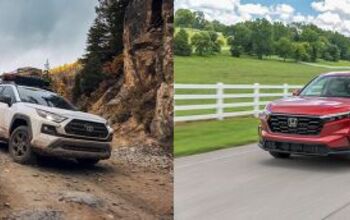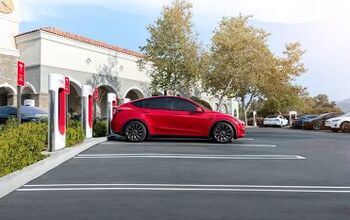Toyota Was Way Off-target With Its Sales Forecast for the Fifth-generation Lexus LS
Over the course of three decades, Lexus has accomplished remarkable feats in the U.S. marketplace. While the modern luxury landscape proves how challenging it is for a (non-Tesla) upstart such as Genesis to garner even an ounce of market share, Toyota’s premium brand generated relatively high volume levels from the get-go.
By 1991, only the third year on the market, Lexus had already overtaken all other import premium brands. By 1998, Lexus was able to top monthly luxury sales leaderboards. Then in 2000, Lexus became America’s top-selling premium marque. The Lexus LS, the brand’s flagship sedan, was an especially important piece of the puzzle in those early days. In fact, when Lexus first outsold Mercedes-Benz and BMW on an annual basis, the LS was one of just three Lexus nameplates. Nearly 43,000 copies of the LS were sold in 1990, for example, at a time when BMW’s 7 Series did just a quarter of that volume; and with Mercedes-Benz some 17,000 units abaft.
But as the LS gained license to move upmarket, as the Great Recession came and went, as the tastes of luxury car buyers became the tastes of luxury SUV buyers, the LS became something of a forgotten flagship. By the end of the fourth-generation LS’s tenure, Lexus was selling barely more than 300 LSs per month in America.
Yet with the launch of a new model in 2018, Lexus intended to dramatically increase the U.S. sales volume for its biggest and most costly sedan. And if at first it looked as though Lexus might just have forecasted accurately, a second glance reveals just how far off the mark even Lexus can be.
It’s not as though we haven’t seen this before with Lexus and its high-end products. Expectations for the LC coupe were chart-toppingly lofty. In 2017, Lexus anticipated monthly sales of 400 units for the LC500 and LC500h duo. Lexus initially hit that target, to be fair, but eventually fell far short. By 2019, Lexus was selling only around 100 LCs per month in the U.S.
In the case of the more mainstream LS, Lexus wanted to take the big four-door from the basement – 4,094 sales in 2017, an all-time low – to 12,000 sales per year with the launch of a new model. Lexus hadn’t topped the 12K mark since 2010 and hadn’t hit five-digit territory since 2013 for that matter. But it was hardly a fantasy. As recently as 2007, Lexus LS sales had risen to the third-highest annual total in the nameplate’s history: 35,226 units, a 16-year high. That was an 80-percent year-over-year increase thanks to the arrival of a new generation. Lexus had seen that sort of increase from a new LS before: in 2001, LS sales basically doubled, year-over-year, to 31,110 units.
2018’s car market, however, was hardly the car market of 2007 or 2001 or 1990.
Oh, at first the new fifth-generation LS moved along quite smartly. 1,008 LS sedans were sold in March 2018; another 999 the following month; another 908 in June of the same year. Then, a weakening of demand became apparent. The 900-unit marker was topped only twice more. In the second-half of the year, Lexus fell 18-percent shy of its monthly target.
And in 2019, the target resembled a moon shot. Year-over-year, U.S. Lexus LS volume decreased in each of the final 11 months of the year. Annual volume, in just the fifth-gen LS’s second model year, plunged 41 percent. Rather than attracting 1,000 buyers per month, the LS attracted 461 on average.
Granted, the market was hardly kind to the LS’s competitors. Mercedes-Benz S-Class sales fell 16 percent to a seven-year low of 12,528 units. BMW 7-Series volume, at 8,823 units, was 15-percent off its 10-year average. Audi only sold 2,963 A8s; half the number of A8s moved just half a decade earlier.
The LS is more overtly stylish than ever before. The LS’s longer/lower/wider look draws an even deeper divide between Lexus’s flagship car and the brand’s big SUVs. The LS still plays a strong value card in a segment controlled by the pricy S-Class.
None of this matters, because Lexus simply misread the mood. It wasn’t the first time, and likely won’t be the last. But it might not be a matter of great significance for a brand that now produces almost three-quarters of its U.S. volume from utility vehicles such as the NX.
Remember the NX? Lexus thought they’d sell around 2,200 per month. Instead, that’s how many NXs Lexus sells every two weeks.
[Images: Lexus]
Timothy Cain is a contributing analyst at The Truth About Cars and Driving.ca and the founder and former editor of GoodCarBadCar.net. Follow on Twitter @timcaincars and Instagram.
More by Timothy Cain
Latest Car Reviews
Read moreLatest Product Reviews
Read moreRecent Comments
- Mike Beranek In the sedan game, it's now either Camry or Accord. The rest are just background noise.
- Theflyersfan I know their quality score hovers in the Tata range, but of all of the Land Rovers out there, this is the one I'd buy in a nanosecond, if I was in the market for an $80,000 SUV. The looks grew on me when I saw them in person, and maybe it's like the Bronco where the image it presents is of the "you're on safari banging around the bush" look. Granted, 99% of these will never go on anything tougher than a gravel parking lot, but if you wanted to beat one up, it'll take it. Until the first warning light.
- Theflyersfan $125,000 for a special M4. Convinced this car exists solely for press fleets. Bound to be one of those cars that gets every YouTube reviewer, remaining car magazine writer, and car site frothing about it for 2-3 weeks, and then it fades into nothingness. But hopefully they make that color widespread, except on the 7-series. The 7-series doesn't deserve nice things until it looks better.
- Master Baiter I thought we wanted high oil prices to reduce consumption, to save the planet from climate change. Make up your minds, Democrats.
- Teddyc73 Oh look dull grey with black wheels. How original.





































Comments
Join the conversation
The problem is that it suffers from "Modern Lexus" flu. That is a hideous look that tries too hard and shows bad taste in as many ways as the dollars it charges.
I liked every LS generation (weak styling on the 01-03, before they sharpened it in 04), but don't like the current model's styling at all. I'd never buy one, because the exterior is ugly and incongruent, and the interior is overworked. They shot themselves in the foot trying to go for a "bold statement" or what have you, and also in the elimination of the V8.